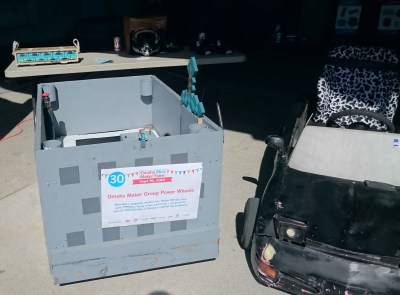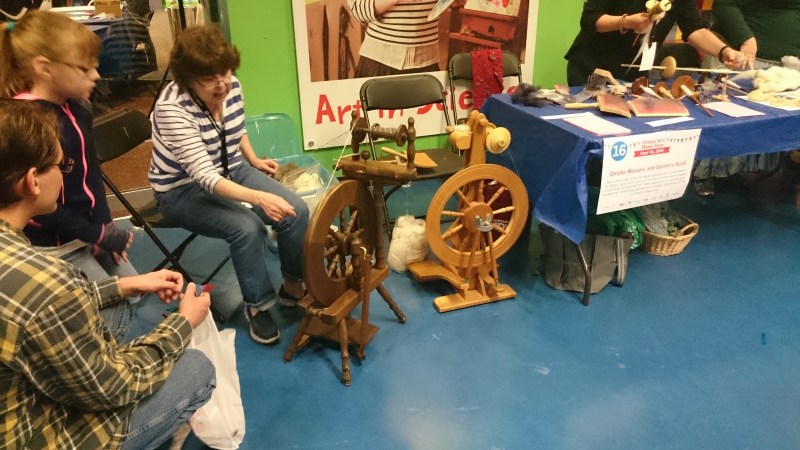The 2nd annual Omaha Mini Maker Faire wasn’t our first rodeo, but it was nonetheless a bit surprising . Before we even made it inside to pay our admission to the Omaha Children’s Museum, I took the opportunity to pet a Transylvanian Naked Neck chicken at one of the outdoor booths. The amiable fowl lives at City Sprouts, an Omaha community farming collective in its 20th year of operation. There seemed to be a theme of bootstrappy sustainability among the makers this year, and that’s great to see.
Just a few feet away sat a mustard-colored 1975 Chevy pickup with a food garden growing in its bed. This is Omaha’s truck farm, an initiative that seeks to educate the city’s kids in the ways of eating locally and growing food at home. On a carnivorous note, [Chad] from Cure Cooking showed my companion and me the correct way to dry-cure meats using time-honored methods.
The DIY spirit continued inside at the Omaha Weavers and Spinners Guild’s booth. A young girl sat enthralled as a woman explained the ins and outs of operating the spinning wheel. We squished and stroked skein after skein of spun fibers like angora, alpaca, and two kinds of camel hair. Across the aisle stood beautiful handmade toy boxes and hope chests made by [Irv] in nearby Brownville.
 But it wasn’t all gardens and greenhouses. Back in Party Room C, members of the University of Nebraska robotics group were steering their creations around the floor on almost exclusively mecanum wheels. Our favorite bot, though was definitely this ball-balancer, made by a young guy at the booth next door to the UN Robotics assembly.
But it wasn’t all gardens and greenhouses. Back in Party Room C, members of the University of Nebraska robotics group were steering their creations around the floor on almost exclusively mecanum wheels. Our favorite bot, though was definitely this ball-balancer, made by a young guy at the booth next door to the UN Robotics assembly.
The Metropolitan Community College Fab Lab commanded half of the museum’s performing arts theater. Ideals Made Real, one of 2014’s makers was back with their popular stop-motion animation booth. Fab Lab member [Chris] showed us his projects from their awesome-sounding class called How to Make Almost Anything, including a 16-pad drum machine and an electric guitar.
Anyone who wants to learn how to use a microcontroller faces two curves: building up circuits and writing code. In the course of teaching his young daughter how to Arduino, [Michael Landon] found that she picked up coding quickly, but was frustrated by breadboarding circuits. In order to keep her interested in microcontrollers, [Michael] developed the LT-1000 trainer board. This is a simple but handy device that features eight LEDs and eight tactile switches connected to rows of header. It’s not meant to be stacked on a board, so it’s compatible with all of them.

Last but not least, several members of the Omaha Maker Group were on hand to spread enthusiasm for making, hacking, and inventing. This year they printed paper whirlygigs that work a lot like the winged maple seed. They even had foamcore boards on hand for creating wind gusts to sustain lift. They had KITT and Steve, their Power Wheels parked out front, and drove them around the parking lot every so often. Steve was built this year and took several medals home from Kansas City a few months ago.































I love the hackaday logo with the doll eyes…
To me it brings to mind maybe a representation of the exact moment of The Singularity (when machines become aware).
… “wait…what?”
classic.
Any amount of feathers missing on a living chicken is ugly! They are also known as “turkins” because of that wattled neck. Ugly. But they taste the same barbecued.
The Balancing Robot by University of Nebraska at Omaha’s Robotics crew is amazing! Never though the VEX Omni Direction wheels would do something like that. Cool work on the 3D printing of the rest of the robot, also.
We had to share!
https://www.facebook.com/NebraskaRobotics/posts/826490564136009